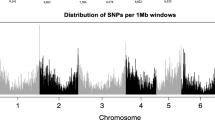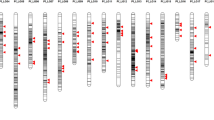Abstract
Pearl millet is the main component of traditional farming systems and a staple grain in the diet of sub-Saharan Africa and India. To facilitate breeding work in this crop, a genetic map consisting of single nucleotide polymorphism (SNP) markers was constructed using an F2 population of 93 progenies, from a wild × cultivated pearl millet cross. We used a modified genotyping-by-sequencing (GBS) protocol involving two restriction enzymes (PstI–MspI) and PCR amplification with primers including three selective bases to generate 3,321 SNPs. Of these, 2,809 high-quality SNPs exhibited a minor allele frequency ≥0.3. In total, 314 non-redundant haplotypes and 85 F2 individuals were used to construct a genetic map spanning a total distance of 640 cM. These SNPs were evenly distributed over seven linkage groups ranging considerably in size (62–123 cM). The average density for this map was 0.51 SNP/cM, and the average interval between SNP markers was 2.1 (±0.6) cM. Finally, to establish bridges between the linkage groups of this and previous maps, 19 SSR markers were examined for polymorphism between the parents of this population. We could only tentatively suggest a correspondence between four of our linkage groups and those of previous maps. Overall, GBS enabled us to quickly produce a genetic map with a density and uniformity of markers greater than previously published maps. The availability of such a map will be useful for the identification of genomic regions associated with Striga resistance and other important agronomic traits.


Similar content being viewed by others
References
Amusan IO, Rich PJ, Menkir A, Housley T, Ejeta G (2008) Resistance to Striga hermonthica in a maize inbred line derived from Zea diploperennis. New Phytol 178:157–166
Bidinger FR, Nepolean T, Hash CT, Yadav RS, Howarth CJ (2007) Identification of QTLs for grain yield of pearl millet [Pennisetum glaucum (L.) R. Br.] in environments with variable moisture during grain filling. Crop Sci 47:969–980
Bradbury PJ, Zhang Z, Kroon DE, Casstevens TM, Ramdoss Y, Buckler ES (2007) TASSEL: software for association mapping of complex traits in diverse samples. Bioinformatics 23:2633–2635
Chemisquy MA, Giussani LM, Scataglini MA, Kellogg EA, Morrone O (2010) Phylogenetic studies favour the unification of Pennisetum, Cenchrus and Odontelytrum (Poaceae): a combined nuclear, plastid and morphological analysis, and nomenclatural combinations in Cenchrus. Ann Bot (Oxford, UK) 106:107–130
Devaux P, Kilian A, Kleinhofs A (1995) Comparative mapping of the barley genome with male and female recombination-derived, doubled haploid populations. Mol Gen Genet 249:600–608
Dhuppe MV, Chavan AA, More AW, More SS, Choudhary LM (2005) Heterosis in pearl millet. J Soils Crops 15(2):343–351
Elshire RJ, Glaubitz JC, Sun Q, Poland JA, Kawamoto K, Buckler ES, Mitchell SE (2011) A robust, simple genotyping-by-sequencing (GBS) approach for high diversity species. PLoS ONE 6(5):e19379. doi:10.1371/journal.pone.0019379
Gowda CLL, Rai KN (2006) Evolution of hybrid parents research. In: Gowda CLL, Rai KN, Freddy BVS, Sana KB (eds) Hybrid parents research at ICRISAT. ICRISAT Center, Patancheru, pp 1–10
Gurney AL, Slate J, Press MC, Scholes JD (2006) A novel form of resistance in rice to the angiosperm parasite Striga hermonthica. New Phytol 169:199–208
Hash CT, Yadav RS, Cavan GP, Howarth CJ, Liu H, Qi X, Sharma A, Kolesnikova-Allen MA, Bidinger FR, Witcombe JR (2000) Marker-assisted backcrossing to improve terminal drought tolerance in pearl millet. In: Ribaut J-M, Poland D (eds) Molecular approaches for the genetic improvement of cereals for stable production in water-limited environments, a strategic planning workshop held at CIMMYT, El Batan, Mexico, 21–25 June 1999, International Maize and Wheat Improvement Center (CIMMYT), Mexico, pp 114–119
Haussmann BIG, Hess DE, Omanya GO, Folkertsma RT, Reddy BVS, Kayentao M, Welz HG, Geiger HH (2004) Genomic regions influencing resistance to the parasitic weed Striga hermonthica in two recombinant inbred populations of sorghum. Theor Appl Genet 109:1005–1016
Jauhar PP, Rai KN, Ozias-Akins P, Chen Z, Hanna WW (2006) Genetic improvement of pearl millet for grain and forage production: cytogenetic manipulation and heterosis breeding. In: Singh RJ, Jauhar PP (eds) Genetic resources, chromosome engineering, and crop improvement, 2nd edn. CRC Press, Taylor & Francis Group, Boca Raton, pp 281–307
Kountche BA, Hash CT, Dodo H, Oumarou L, Sanogo MD, Amadou T, Vigouroux Y, This D, Nijkamp R, Haussmann BIG (2013) Development of a pearl millet Striga-resistant genepool: response to five cycles of recurrent selection under Striga-infested field conditions in West Africa. Field Crop Res 154:82–90
Lander ES, Green P, Abrahamson J, Barlow A, Daly MJ, Lincoln SE, Newberg L (1987) MAPMAKER: an interactive computer package for constructing primary genetic linkage maps of experimental and natural populations. Genomics 1:174–181
Liu CJ, Witcombe JR, Pittaway TS, Nash M, Busso CS, Hash CT, Gale MD (1994) An RFLP-based genetic map of pearl millet (Pennisetum glaucum). Theor Appl Genet 89:481–487
Lu H, Romero-Severson J, Bernardo R (2002) Chromosomal regions associated with segregation distortion in maize. Theor Appl Genet 105:622–628
Lu F, Lipka AE, Glaubitz J, Elshire R, Cherney JH, Casler MD, Buckler ES, Costich DE (2013) Switchgrass genomic diversity, ploidy, and evolution: novel insights from a network-based SNP discovery protocol. PLoS Genet 9(1):e1003215. doi:10.1371/journal.pgen.1003215
Manning K, Pelling R, Higham T, Schwenniger JL, Fuller DQ (2011) 4500-Year old domesticated pearl millet (Pennisetum glaucum) from the Tilemsi Valley, Mali: new insights into an alternative cereal domestication pathway. J Archaeol Sci 38(2):312–322
Mariac C, Luong V, Kapran I, Mamadou A, Sagnard F, Deu M, Chantereau J, Gerard B, Ndjeunga J, Bezançon G, Pham J, Vigouroux Y (2006) Diversity of wild and cultivated pearl millet accessions [Pennisetum glaucum (L.) R. Br.] in Niger assessed by microsatellite markers. Theor Appl Genet 114:49–58
Omanya GO, Haussmann BIG, Hess DE, Reddy BVS, Kayentao M, Welz HG, Geiger HH (2004) Utility of indirect and direct selection traits for improving striga resistance in two sorghum recombinant inbred populations. Field Crop Res 89:237–252
Pedraza-Garcia F, Specht JE, Dweikat I (2010) A new PCR-based linkage map in pearl millet. Crop Sci 50:1754–1760. doi:10.2135/cropsci2009.10.0560
Poland JA, Brown PJ, Sorrells ME, Jannink JL (2012) Development of high-density genetic maps for barley and wheat using a novel two-enzyme genotyping-by-sequencing approach. PLoS ONE 7(2):e32253. doi:10.1371/journal.pone.0032253
Presterl T, Weltzien E (2003) Exploiting heterosis in pearl millet for population breeding in arid environments. Crop Sci 43:767–776. doi:10.2135/cropsci2003.7670
Qi X, Pittaway TS, Lindup S, Liu H, Waterman E, Padi FK, Hash CT, Zhu J, Gale MD, Devos KM (2004) An integrated genetic map and a new set of simple sequence repeat markers for pearl millet Pennisetum glaucum. Theor Appl Genet 109:1485–1493
Quarrie SA, Steed A, Calestani C, Semikhodskii A, Lebreton C, Chinoy C, Steele N, Pljevljakusic D, Waterman E, Weyen EJ, Schondelmaier J, Habash DZ, Farmer P, Saker L, Clarkson DT, Abugalieva A, Yessimbekova M, Turuspekov Y, Abugalieva S, Tuberosa R, Sanguineti M-C, Hollington PA, Aragués R, Royo A, Dodig D (2005) A high-density genetic map of hexaploid wheat (Triticum aestivum L.) from the cross Chinese Spring 9 SQ1 and its use to compare QTLs for grain yield across a range of environments. Theor Appl Genet 110:865–880
Rai KN, Govindaraj M, Rao AS (2012) Genetic enhancement of grain iron and zinc content in pearl millet. Qual Assur Saf Crops Foods 4(3):119–125. doi:10.1111/j.1757-837X.2012.00135.x
Rajaram V, Nepolean T, Senthilvel S, Varshney RK, Vadez V, Srivastava RK, Shah TM, Supriya A, Kumar S, Kumari BR, Bhanuprakash A, Narasu ML, Riera-Lizarazu O, Hash CT (2013) Pearl millet [Pennisetum glaucum (L.) R. Br.] consensus linkage map constructed using four RIL mapping populations and newly developed EST-SSRs. BMC Genom 14:159
Sehgal D, Rajaram V, Armstead IP, Vadez V, Yadav YP, Hash CT, Yadav RS (2012) Integration of gene-based markers in a pearl millet genetic map for identification of candidate genes underlying drought tolerance quantitative trait loci. BMC Plant Biol 12:9. doi:10.1186/1471-2229-12-9
Senthilvel S, Jayashree B, Mahalakshmi V, Kumar PS, Nakka S, Nepolean T, Hash CT (2008) Development and mapping of simple sequence repeat markers for pearl millet from data mining of expressed sequence tags. BMC Plant Biol 8:119. doi:10.1186/1471-2229-8-119
Sharma PC, Singh D, Sehgal D, Singh G, Hash CT, Yadav RS (2014) Further evidence that a terminal drought tolerance QTL of pearl millet is associated with reduced salt uptake. Environ Exp Bot. doi:10.1016/j.envexpbot.2014.01.013
Sonah H, Bastien M, Iquira E, Tardivel A, Légaré G et al (2013) An improved genotyping by sequencing (GBS) approach offering increased versatility and efficiency of SNP discovery and genotyping. PLoS ONE 8(1):e54603. doi:10.1371/journal.pone.0054603
Supriya A, Senthilvel S, Nepolean T, Eshwar K, Rajaram V, Shaw R, Hash CT, Kilian A, Yadav RC, Narasu ML (2011) Development of a molecular linkage map of pearl millet integrating DArT and SSR markers. Theor Appl Genet 123:239–250. doi:10.1007/s00122-011-1580-1
Tinker N (2013) Genotype-by-sequence in oat. Agriculture and Agri-Food Canada. Retrieved from http://www.9ioc.net/02-Tinker_Nick.pdf
Tostain S, Marchais L (1993) Évaluation de la diversité génétique des mils (Pennisetum glaucum (L.) R. BR.) au moyen de marqueurs enzymatiques et relations entre formes sauvages et cultivées. Laboratoire Ressources Génétiques et Amélioration des Plantes Tropicales. ORSTOM, Montpellier Cedex 1
Voorrips RE (2002) MapChart: software for the graphical presentation of linkage maps and QTLs. J Hered 93(1):77–78. doi:10.1093/jhered/93.1.77
Wilson JP, Hess DE, Hanna WW, Kumar KA, Gupta SC (2004) Pennisetum glaucum subsp. monodii accessions with Striga resistance in West Africa. Crop Prot 23:865–870
Xu Y, Zhu L, Xiao J, Huang N, McCouch SR (1997) Chromosomal regions associated with segregation distortion of molecular markers in F2, backcross, doubled haploid and recombinant inbred populations of rice (Oryza sativa L.). Mol Gen Genet 253:535–545
Yoshida S, Shirasu K (2009) Multiple layers of incompatibility to the parasitic witchweed, Striga hermonthica. New Phytol 183:180–189
Acknowledgments
The support of the International Crops Research Institute for the Semi-Arid Tropics (ICRISAT) and the Institut de Recherche pour le Développement (IRD) are acknowledged. We would like also to thank the Institut de Biologie Intégrative et des Systèmes (IBIS) at Université Laval for their involvement in the process of GBS. This publication was finalized as part of the CGIAR Research Program on Dryland Cereals.
Author information
Authors and Affiliations
Corresponding author
Electronic supplementary material
Below is the link to the electronic supplementary material.
Rights and permissions
About this article
Cite this article
Moumouni, K.H., Kountche, B.A., Jean, M. et al. Construction of a genetic map for pearl millet, Pennisetum glaucum (L.) R. Br., using a genotyping-by-sequencing (GBS) approach. Mol Breeding 35, 5 (2015). https://doi.org/10.1007/s11032-015-0212-x
Received:
Accepted:
Published:
DOI: https://doi.org/10.1007/s11032-015-0212-x




